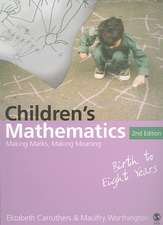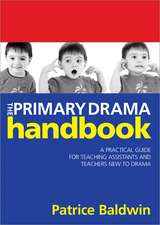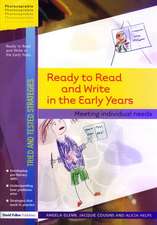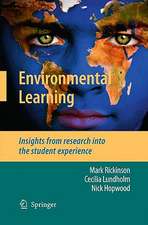Let History into the Mathematics Classroom: History of Mathematics Education
Autor Évelyne Barbin, Jean-Paul Guichard, Marc Moyon, Patrick Guyot, Catherine Morice-Singh, Frédéric Métin, Martine Bühler, Dominique Tournès, Renaud Chorlay, Gérard Hamonen Limba Engleză Hardback – 10 noi 2017
One of the main values of history is to show that the notions and concepts we teach were invented to solve problems. The different chapters of this collection all have, as their starting points, historic problems—mathematical or not. These are problems of exchanging and sharing, of dividing figures and volumes as well as engineers’ problems, calculations, equations and congruence. The mathematical reasoning which accompanies these actions is illustrated by the use of drawings, folding, graphical constructions and the production of machines.
| Toate formatele și edițiile | Preț | Express |
|---|---|---|
| Paperback (1) | 676.83 lei 38-44 zile | |
| Springer International Publishing – 24 iun 2018 | 676.83 lei 38-44 zile | |
| Hardback (1) | 778.84 lei 43-57 zile | |
| Springer International Publishing – 10 noi 2017 | 778.84 lei 43-57 zile |
Preț: 778.84 lei
Preț vechi: 949.80 lei
-18% Nou
Puncte Express: 1168
Preț estimativ în valută:
149.16€ • 153.68$ • 124.95£
149.16€ • 153.68$ • 124.95£
Carte tipărită la comandă
Livrare economică 24 februarie-10 martie
Preluare comenzi: 021 569.72.76
Specificații
ISBN-13: 9783319571492
ISBN-10: 3319571494
Pagini: 162
Ilustrații: XXIV, 146 p. 61 illus., 16 illus. in color.
Dimensiuni: 178 x 254 mm
Greutate: 0.52 kg
Ediția:1st ed. 2018
Editura: Springer International Publishing
Colecția Springer
Seria History of Mathematics Education
Locul publicării:Cham, Switzerland
ISBN-10: 3319571494
Pagini: 162
Ilustrații: XXIV, 146 p. 61 illus., 16 illus. in color.
Dimensiuni: 178 x 254 mm
Greutate: 0.52 kg
Ediția:1st ed. 2018
Editura: Springer International Publishing
Colecția Springer
Seria History of Mathematics Education
Locul publicării:Cham, Switzerland
Cuprins
Angles in Secondary School: Surveying and Navigation.- Dividing a Triangle in the Middle Ages: An Example From the Latin Works on Practical Geometry.- A Square in a Triangle.- Indian Calculation: The Rule of Three--Quite a Story.- The Arithmetic of Juan de Ortega: Equations without Algebra.- The Congruence Machine of the Carissan Brothers.- A Graphical Approach to Euler’s Method.- Calculating with Hyperbolas and Parabolas.- When Leibniz Plays Dice.- The Probability of Causes According to Condorcet.
Recenzii
“This book has many strengths: the broad and engaging range of topics, the clear structure of the lessons and the detailed presentation of the history with a good use of images. To teachers, in particular, this book is certainly a compelling call to value the importance of history in the maths classroom but there is much of interest to any mathematician here.” (Sean Springer, London Mathematical Society Newsletter, newsletter.lms.ac.uk, Issue 478, September, 2018)
Notă biografică
Évelyne Barbin is full professor of epistemology and history of sciences at the University of Nantes (France), she is member of the Laboratory of Mathematics Jean Leray (LMJL, UMR 6629) and of the Institute for Research in Mathematics Education (IREM). Her research concerns history of mathematics, history of mathematics teaching and relations between history and teaching of mathematic. As convenor of the IREM National Committee “Epistemology and History of Mathematics”, she organised thirty colloquia and summer universities. She edited more than 25 books. Since 1980, she is member of the International HPM Group and she was chair from 2008 to 2012. Her recent works concern the history of descriptive geometry.
Martine Bühler is a mathematics teacher in a high school (Lycée Flora Tristan) at Noisy-le-Grand (France). She works with the group “Mathematics: Approach Through Historical texts” (M.: A.T.H.) of the Institute for Research in Mathematics Education (IREM) of Paris. For many years now, the group, founded by Jean-Luc Verley, who was then a mathematics lecturer at the University of Paris 7, reflects about the use of historical texts with the students to introduce a notion or as a source of interesting problems in liaison with the curriculum. The group published brochures and articles on this subject, with descriptions of experiments in the classroom.
Renaud Chorlay had been trained in the social sciences at Sciences-Po Paris, in mathematics and history of mathematics at Paris Diderot University. He works in the teacher-training department of Paris Sorbonne University. He is member of the Institute for Research in Mathematics Education (IREM) of Paris, of the IREM National Committee “Epistemology and History of Mathematics” and of the International HPM Group. His main research field is the history of mathematics in the modern period, with specific interests in qualitative analysis, topology and differential geometry. He also works on the connections between history and teaching of mathematics, either in the classroom, in teacher-training, or in theoretical didactics.
Jean-Paul Guichard is professor of mathematics, working at the Institute for Research in Mathematics Education (IREM) of Poitiers (France). He is member of a research group which elaborates curricula for the secondary school to learn mathematics through magnitudes with nine publications by this time. Member of the IREM National Committee “Epistemology and History of Mathematics”, for a long time, he collaborates with its publications. His main interest in history concerns François Viète and the circulation of literal calculation, but also negative numbers and magnitudes. Recently he has been working on how squaring one or several figures in different cultures.
Patrick Guyot is a (retired) mathematics and physics teacher, who worked at vocational high school Dumaine in Mâcon (France). He is a teacher trainer at the University of Burgundy, a member of the IREM of Dijon (Institute for Research in Mathematics Education) and the IREM National Committee “Epistemology and History of Mathematics”. He earned his PhD in philosophy from the University of Burgundy in 2012, in the field of history and philosophy of 18th century physics. His research interests include philosophy of physics as well as history of mathematics. His current research focuses on Pierre Sigorgne, a talented but not well-known scientist of the Enlightenment.
Gérard Hamon is a senior teacher of mathematics and he has written many books related to the teaching of mathematics for the upper secondary school. He has been involved in teachers basic training in France and Africa and in-service teacher training in France. He is a member of the Institute for Research in Mathematics Education (IREM) of Rennes and the IREM National Committee “Epistemology and History of Mathematics” and is author and co-author of several books about the history of mathematics. His most recent work on Tartaglia’s solution of cubic equations Questions et inventions diverses Livre IX ou l’invention de la résolution des équations du troisième degré is published by Hermann, Paris.
Frédéric Métin is a teacher trainer and mathematics educator at the University of Burgundy in Dijon (France), and a PhD student at the University in Nantes (France), under supervision of Prof. Evelyne Barbin. His research relates to practical mathematics in early modern Europe, focusing on practical geometry and the use of instruments. He specifically works for his PhD on 17th century fortification, its link to geometry and its transformation in a teaching discipline. He is a member of the Institute for Research in Mathematics Education (IREM) of Dijon and the National Committee “Epistemology and History of Mathematics”, in which he participated in several editorial projects.<
Catherine Morice-Singh taught mathematics for many years in Delhi (India) at middle and higher secondary level in an Establishment belonging to the Agency for French Education Abroad (AEFE) and completed her MA in Hindi and MPhil in Indian Studies (Sanskrit). Back in France in 2004, she joined the Institute for Research in Mathematics Education (IREM) at the University Paris Diderot (Paris 7) and devoted more time for research, working on different Sanskrit mathematical texts. She specialised in the study of Jaina Mathematics and did her PhD from the University Sorbonne Nouvelle (Paris 3) on Jaina Mathematics and Cosmology.
Marc Moyon is lecturer in history of mathematics at the University of Limoges (France). He is member of the Mathematics and Computer Sciences Department of Limoges (XLIM, UMR 7252) and assistant director of the Institute for Research in Mathematics Education (IREM) of Limoges. His main research focuses on history of mediaeval mathematics (Arab and Latin). He is also interested by history of mathematics teaching in Primary School (19th and 20th c.) and the introduction of an historical perspective in mathematics education. For his work on medieval geometry of measurement, he has received in 2011 the “International Award for Young Scholars” from the International Academy for History of Sciences.
Dominique Tournès is full professor of mathematics and history of mathematics at the University of La Réunion (France). He is a member of the Laboratory of Computer Science and Mathematics (LIM, EA 2525) and director of the Institute for Research in Mathematics of Education (IREM). For more than 30 years he is engaged in the training of future teachers of mathematics. His research concerns history of numerical analysis, mathematical instruments and mathematics of engineers during the period 1750-1950. Since 2014 he is a convenor of the IREM National Committee “Epistemology and History of Mathematics”.
Caracteristici
Introduces an historical perspective to mathematics teaching for 11 to 18-year-olds by featuring ten notable experiments from problem-solvers of the past. Places well-known mathematicians, practitioners and engineers in their scientific and cultural contexts. Focuses on ancient Greek, Indian, Chinese and Arabic mathematics as well as contemporary mathematics. Includes supplementary material: sn.pub/extras


















